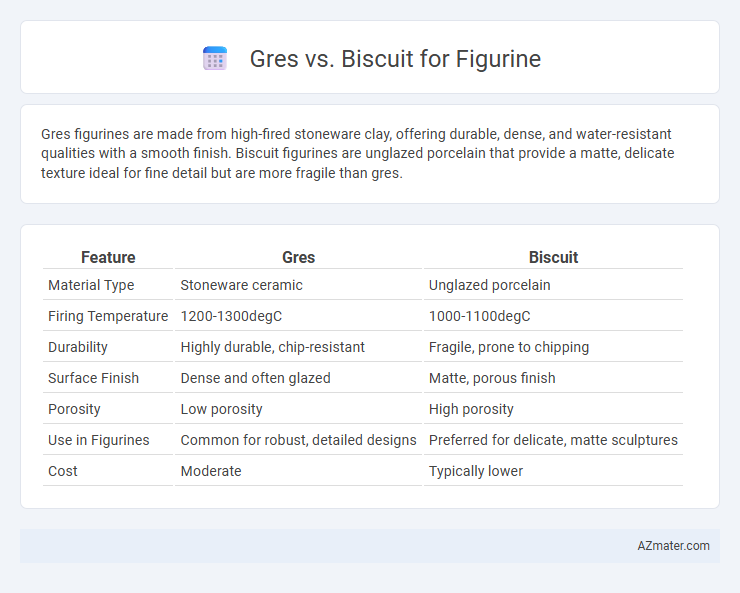Gres figurines are made from high-fired stoneware clay, offering durable, dense, and water-resistant qualities with a smooth finish. Biscuit figurines are unglazed porcelain that provide a matte, delicate texture ideal for fine detail but are more fragile than gres.
Table of Comparison
| Feature | Gres | Biscuit |
|---|---|---|
| Material Type | Stoneware ceramic | Unglazed porcelain |
| Firing Temperature | 1200-1300degC | 1000-1100degC |
| Durability | Highly durable, chip-resistant | Fragile, prone to chipping |
| Surface Finish | Dense and often glazed | Matte, porous finish |
| Porosity | Low porosity | High porosity |
| Use in Figurines | Common for robust, detailed designs | Preferred for delicate, matte sculptures |
| Cost | Moderate | Typically lower |
Introduction: Understanding Gres and Biscuit in Figurine Making
Gres and biscuit represent two distinct ceramic materials used in figurine making, each valued for unique qualities that affect texture and durability. Gres, a type of stoneware clay, offers high strength and resistance to firing at high temperatures, making it ideal for intricate and robust figurines. Biscuit, or bisque porcelain, is unglazed ceramic with a matte finish, prized for its delicate, refined appearance and often used in collectible figurines and decorative art.
Material Composition: Gres vs Biscuit
Gres figurines are made from a dense, stoneware clay fired at high temperatures, resulting in a durable, vitrified surface with minimal porosity. Biscuit figurines, on the other hand, consist of unglazed porcelain or bisque, showcasing a matte finish with a more delicate texture and slightly more porous composition. The material composition of gres provides greater strength and resistance to chipping compared to the softer, more fragile nature of biscuit porcelain.
Historical Origins of Gres and Biscuit Figurines
Gres figurines, originating from 19th-century European stoneware traditions, are known for their dense, durable clay body and rich, earthy tones. Biscuit figurines, developed in the 18th century, are unglazed porcelain pieces with a matte finish, prized for their delicate, detailed craftsmanship and resemblance to sculptures. Both styles reflect unique historical ceramic techniques and cultural influences, with gres emphasizing sturdiness and biscuit highlighting refined artistic expression.
Texture and Surface Finish Comparison
Gres figurines feature a dense, stoneware texture that offers a smooth, matte finish with excellent durability and resistance to chipping, making them ideal for detailed sculptural work. Biscuit porcelain, also known as bisque, presents a porous, unglazed surface with a soft, velvety texture that enhances fine detail visibility and gives a more delicate, lifelike appearance. The contrast between gres's robust, uniform surface and biscuit's fragile, powdery finish significantly influences the aesthetic and tactile experience of collectible figurines.
Durability and Strength: Gres vs Biscuit
Gres figurines exhibit superior durability due to their dense, stoneware composition, making them highly resistant to chipping and cracking under impact. Biscuit porcelain, while prized for its delicate matte finish and fine detailing, is more fragile and prone to damage when subjected to rough handling or accidental drops. Collectors seeking long-lasting strength often prefer gres for sculptures requiring robustness, whereas biscuit suits decorative pieces with less handling risk.
Artistic Detailing and Suitability
Gres offers a dense, durable texture that enhances fine artistic detailing in figurines, making it ideal for intricate designs and smooth finishes. Biscuit porcelain, known for its matte, unglazed surface, provides a softer aesthetic that highlights subtle sculptural nuances with a delicate, understated elegance. Both materials suit different artistic intentions, with Gres excelling in detailed precision and Biscuit favoring a refined, classical appearance.
Firing Temperatures and Production Processes
Gres figurines are fired at higher temperatures, typically between 1200degC and 1300degC, resulting in a dense, vitrified body that is highly durable and water-resistant. Biscuit figurines undergo a lower firing temperature, usually around 900degC to 1000degC, preserving their matte, porous surface but making them more fragile. The production process for gres involves high-pressure molding and glazing post-firing, while biscuit figurines are often left unglazed and hand-finished to maintain their delicate, porous texture.
Color and Glaze Application Differences
Gres figurines typically feature a matte, earthy texture with muted, natural colors due to their low-porosity stoneware composition, while biscuit figurines exhibit a fine, unglazed porcelain surface that offers a soft, chalky white appearance. The glaze application on gres is often minimal or absent, emphasizing the raw clay's natural hues and texture, whereas biscuit figurines are deliberately left unglazed to highlight their delicate, matte finish and intricate sculptural details. These differences in color and glaze not only affect the visual appeal but also influence the tactile experience and durability of each type of figurine.
Typical Uses in Modern and Classic Figurines
Gres clay is favored for modern figurines due to its high durability, fine texture, and ability to capture intricate details, making it ideal for both artistic and functional decorative pieces. Biscuit, also known as bisque porcelain, is commonly used in classic figurines, valued for its matte finish and smooth surface that enhances the timeless elegance of traditional designs. Both materials support different aesthetic and structural needs, with gres excelling in robust, finely detailed creations and biscuit preferred for delicate, refined sculptures.
Choosing the Best Material: Gres or Biscuit?
Gres and biscuit porcelain each offer unique qualities for figurines, with gres known for its durability and matte finish, making it ideal for intricate, long-lasting sculptures. Biscuit, or unglazed porcelain, provides a smooth texture and delicate appearance, preferred for fine details and antique-style collectibles. Choosing between gres and biscuit depends on the desired aesthetic, texture, and resilience of the figurine, with gres favored for robustness and biscuit prized for subtle elegance.

Infographic: Gres vs Biscuit for Figurine
 azmater.com
azmater.com